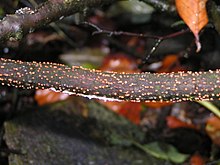The Nectriaceae comprise a family of fungi in the order Hypocreales. It was circumscribed by brothers Charles and Louis René Tulasne in 1865.[1] In 2020, an Outline of fungi was produced and listed 70 genera and about 1,336 species.[2]
| Nectriaceae | |
|---|---|

| |
| Nectria cinnabarina | |
| Scientific classification | |
| Domain: | Eukaryota |
| Kingdom: | Fungi |
| Division: | Ascomycota |
| Class: | Sordariomycetes |
| Order: | Hypocreales |
| Family: | Nectriaceae Tul. & C.Tul. (1844) |
| Type genus | |
| Nectria (Fr.) Fr. (1849)
| |
| Genera | |
|
See text | |
It is a highly diverse group with a worldwide distribution and it has higher diversity in warm temperate and tropical regions (Rossman et al. 1999;[3] Rossman 2000; Chaverri et al. 2011, Schroers et al. 2011,[4] Hyde et al. 2014, Lombard et al. 2015,[5]). Several authors have studied and revised the taxonomy of Nectriaceae (Petch 1938;[6] Munk 1957; Dennis 1960; Kreisel 1969; Rossman et al. 1999;[3] Lumbsch and Huhndorf 2010; Lombard et al. 2015; Maharachchikumbura et al. 2016b).[7] A recent treatment of Nectriaceae was provided by Wijayawardene et al. (2022), they also accepted 70 genera within the family.[8]
List of genera edit
As accepted by Wijayawardene et al. 2020; (with number of species)[2]
- Albonectria Rossman & Samuels (1)
- Allantonectria Earle (1)
- Allonectella Petr. (2)
- Aphanocladium W. Gams (4)
- Aquanectria L. Lombard & Crous (3)
- Atractium Link (3)
- Baipadisphaeria Pinruan (1)
- Bisifusarium L. Lombard, Crous & W. Gams (7)
- Calonectria De Not. (400)
- Calostilbe Sacc. & Syd. (4)
- Campylocarpon Halleen, Schroers & Crous (3)
- Chaetonectrioides Matsush. (1)
- Chaetopsina Rambelli (19)
- Coccinonectria Lombard & Crous (2)
- Corallomycetella Henn. (4)
- Corallonectria C. Herrera & P. Chaverri (1)
- Corinectria C. González & P. Chaverri (3)
- Cosmospora Rabenh. (50)
- Cosmosporella S.K. Huang, R. Jeewon & K.D. Hyde (1)
- Curvicladiella Decock & Crous (1)
- Cyanochyta Höhn. (1)
- Cyanonectria Samuels & Chaverri (2)
- Cyanophomella Höhn. (1)
- Cylindrocladiella Boesew. (45)
- Cylindrodendrum Bonord. (4)
- Dacryoma Samuels (2)
- Dactylonectria L. Lombard & Crous (14)
- Dematiocladium Allegr., Aramb., Cazau & Crous (2)
- Fusarium Link (ca. 120)
- Fusicolla Bonord (18)
- Geejayessia Schroers, Gräfenhan & Seifert (7)
- Gibberella
- Gliocephalotrichum J.J. Ellis & Hesselt. (13)
- Gliocladiopsis S.B. Saksena (15)
- Glionectria Crous & C.L. Schoch (1)
- Ilyonectria P. Chaverri & C. Salgado (23)
- Macroconia (Wollenw.) Gräfenhan, Seifert & Schroers (5)
- Mariannaea G. Arnaud ex Samson (22)
- Microcera Desm. (4)
- Murinectria M. Niranjan & V.V. Sarma (4)
- Nalanthamala Subram. (6)
- Nectria (Fr.) Fr. (29)
- Neocalonectria Crous (1)
- Neocosmospora E.F. Sm. (84)
- Neonectria Wollenw. (30)
- Neothyronectria Crous & Thangavel (2)
- Ophionectria Sacc. (39)
- Pandanaceomyces Tibpromma & K.D. Hyde (1)
- Paracremonium L. Lombard & Crous (5)
- Payosphaeria W.F. Leong (1)
- Penicillifer Emden (7)
- Persiciospora P.F. Cannon & D. Hawksw. (4)
- Pleiocarpon L. Lombard & D. Aiello (3)
- Pleogibberella Sacc. (3)
- Pleurocolla Petr. (1)
- Pseudoachroiostachys Tibpromma & K.D. Hyde (1)
- Pseudocosmospora C. Herrera & P. Chaverri (13)
- Pseudonectria Seaver (17)
- Rectifusarium L. Lombard, Crous & W. Gams (2)
- Rugonectria P. Chaverri & Samuels (5)
- Sarcopodium Ehrenb. (22)
- Stylonectria Höhn. (5)
- Thelonectria P. Chaverri & C.G. Salgado (46)
- Thyronectria Sacc. (41)
- Varicosporella Lechat & J. Fourn. (1)
- Varicosporellopsis Lechat & J. Fourn. (1)
- Volutella Fr. (127)
- Xenoacremonium Lombard & Crous (2)
- Xenocylindrocladium Decock, Hennebert & Crous (3)
- Xenogliocladiopsis Crous & W.B. Kendr. (2)
- Xenoleptographium Marinc., T.A. Duong, Z.W. de Beer & M.J. Wingf. (1)
- XenonectriellaWeese (18)
References edit
- ^ Tulasne LR, Tulasne C (1865). Selecta Fungorum Carpologia: Nectriei- Phacidiei- Pezizei (in Latin). Vol. 3. Paris, France: Imperatoris Jussu, In Imperiali Typographeo Excudebatur. p. 3.
- ^ a b Wijayawardene, Nalin; Hyde, Kevin; Al-Ani, Laith Khalil Tawfeeq; Somayeh, Dolatabadi; Stadler, Marc; Haelewaters, Danny; et al. (2020). "Outline of Fungi and fungus-like taxa". Mycosphere. 11: 1060–1456. doi:10.5943/mycosphere/11/1/8. hdl:10481/61998.
- ^ a b Rossman, A.Y.; Samuels, G.J.; Rogerson, C.T.; Lowen, R. (1999). "Genera of Bionectriaceae, Hypocreaceae and Nectriaceae (Hypocreales, Ascomycetes)". Stud. Mycol. 42: 1–260.
- ^ Schroers, H.J.; Gräfenhan, T.; Nirenberg, H.I.; Seifert, K.A. (2011). "A revision of Cyanonectria and Geejayessia gen. nov., and related species with Fusarium-like anamorphs". Stud. Mycol. 68: 115–138.
- ^ Lombard, L.; Van der Merwe, N.A.; Groenewald, J.Z.; Crous, P.W. (2015). "Generic concepts in Nectriaceae". Stud. Mycol. 80: 189–245.
- ^ Petch, T. (1938). "British Hypocreales". Trans. Br. Mycol. Soc. 21: 243–301.
- ^ Maharachchikumbura, Sajeewa S. N.; Hyde, Kevin D.; Jones, E. B. Gareth; McKenzie, E. H. C.; Bhat, Jayarama D.; Dayarathne, Monika C.; Huang, Shi-Ke; Norphanphoun, Chada; Senanayake, Indunil C. (2016-06-03). "Families of Sordariomycetes". Fungal Diversity. 79 (1): 1–317. doi:10.1007/s13225-016-0369-6. ISSN 1560-2745.
- ^ Wijayawardene, N.N.; Hyde, K.D.; Dai, D.Q.; Sánchez-García, M.; Goto, B.T.; Saxena, R.K.; et al. (2022). "Outline of Fungi and fungus-like taxa – 2021". Mycosphere. 13 (1): 53–453 [160]. doi:10.5943/mycosphere/13/1/2. hdl:10481/76378. S2CID 249054641.